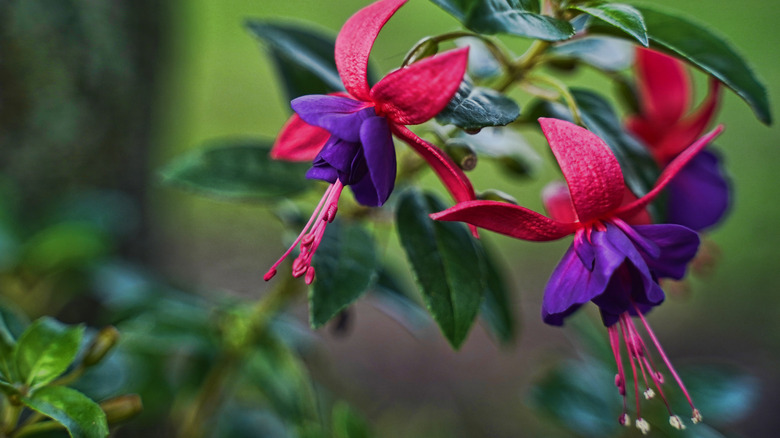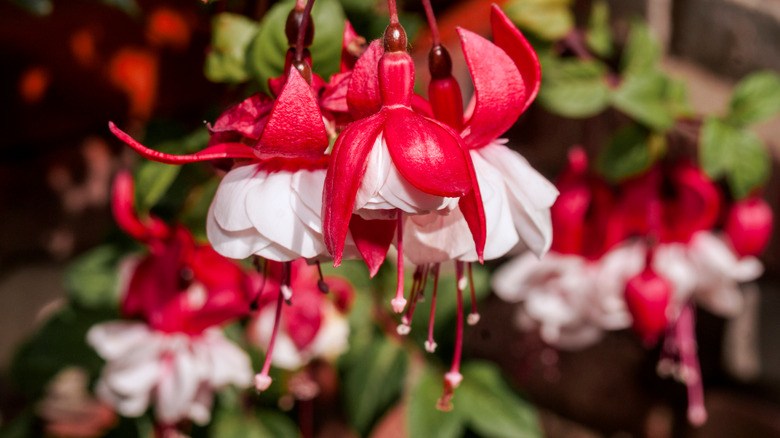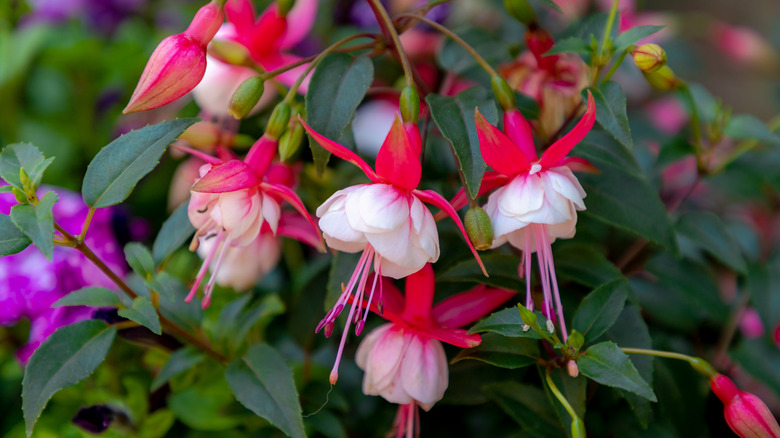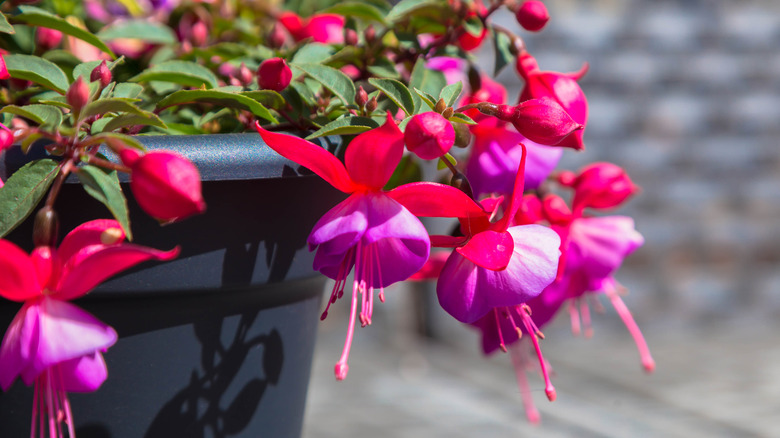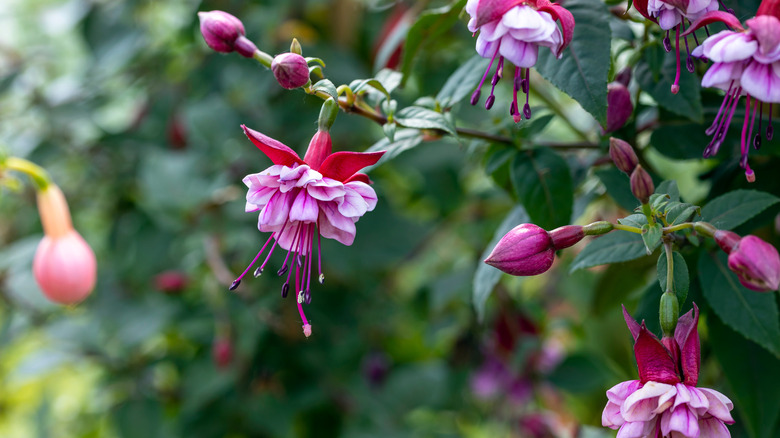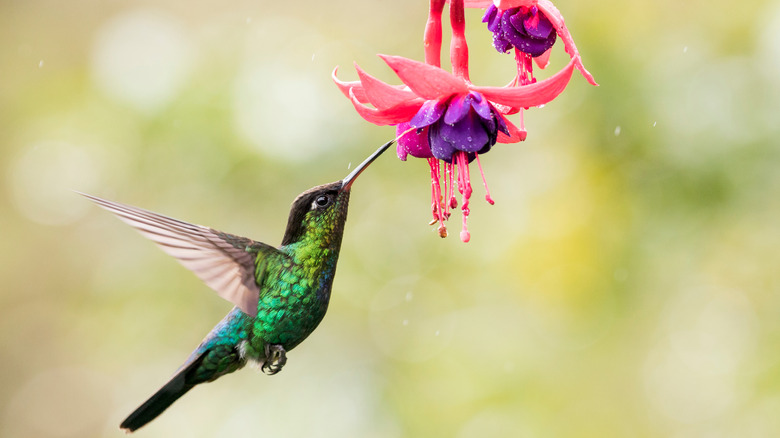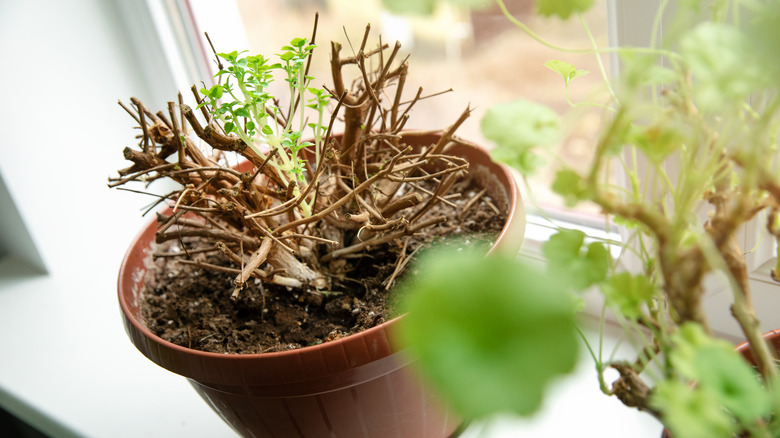How To Successfully Care For Fuchsia Plants
The charming fuchsia (Fuchsia triphylla) is the bastion of the summer flowerbed, producing pendant-shaped flowers with a bell-like form that bloom at the beginning of June until the first few touches of frost in the fall hit the ground. Fuchsia flowers bloom in various colors and variations, allowing gardeners to create stunning flowerbed displays. They are fantastic for container gardening, but also for vertical gardens and hanging flower baskets.
First discovered on the Caribbean island of Hispaniola — which encompasses Haiti and the Dominican Republic — fuchsia don't need regular maintenance, but you should still keep an eye on them. With more than 110 species identified so far, most fuchsia plants reach 1 to 8 feet tall, Homyden noted. Their leaves are simple lanceolate with serrated margins and can be deciduous or evergreen, depending on the species. These plants look great on their own in a pot, but they also go well with complementary or contrasting hues. If you want to please your eyes with a heavenly color combination each day, display your fuchsias near oxalis, lobelia, angel wing begonias, or coleus.
Fuchsia plants have become so widespread in South America and other climates that they are now designated invasive species in certain regions. Before planting fuchsia, keep this in mind, and check with your local extension office to ensure it's safe to do so.
How to use fuchsia plants in garden
As Thompson & Morgan mentions, fuchsia plants are adaptable shrubs that bloom throughout most of the summer, and for a relatively minimal effort, you'll be rewarded with a beautiful display of pendant flowers. Fuchsia can be planted in borders, beds, window boxes, hanging baskets, and pots in full sun or partial shade. They add color to practically any surface you can shake a trowel at, and you have the option to choose between evergreen and deciduous plants, depending on what you want to achieve in your garden. For instance, hybrid fuchsias are the most widely available type and are normally grown in pots. Miniature fuchsias are smaller hybrid fuchsias that extend to roughly 2 inches tall and are typically sold in little plastic pots. Lastly, climbing fuchsia is the tallest of the three types, reaching up to 6 feet tall, and is usually cultivated in large outside containers.
Keep in mind that fuchsia flowers only bloom once but can deliver new growing seasons if pinched. Pinch back a bloom as soon as it starts to fade, and most of the time, you'll be rewarded with a new, vivid flower within a few weeks. If you keep pinching back the blossoms as needed, fuchsia can bloom multiple times in a single season. However, in case you don't see fresh blossoms after six weeks, trim the stem back even more to the first strong node and give it more time to grow.
How to grow fuchsia plants
Fuchsias require a decent amount of natural light every day. However, there is a limit to how much light they require, so make sure to avoid placing the growing plant in a place where it will be exposed to the sun in the afternoon. The ideal planting time for most fuchsia types is in late May to early June, whether planted in the flowerbed outside or a pot. They can be grown in regular potting soil and will provide excellent flowers throughout the summer and strong foliage during all seasons.
As Gardening Know How notes, it's best to propagate fuchsia during the spring, but summer and fall are also excellent propagation seasons. Cut the stems just above the third set of leaves when propagating the plant, making an incision just below the leaf node. It would help to wrap a plastic bag around the pot and secure it with an elastic band to aid the plant's growth. Place it in a warm area to help it sprout. Maintain a consistent moisture level in the soil at regular intervals, but don't let it become wet. It's also a good idea to add a lot of organic matter to the potting soil. The buds will demand a few vital nutrients during the blooming season; therefore, adding organic matter increases the likelihood of flower production. You can remove the plastic bag once new sprouts appear and move the cuttings into individual containers after a few weeks.
How to care for fuchsia plants
Fuchsias require a humid climate to grow into their full splendor; thus, make sure to keep the soil moist but not soggy. Excessive moisture stuck in the soil for long periods can lead to root rot, rendering the plant unable to bloom. On the other hand, overwatering can promote a swarm of fungal illnesses, so when you propagate the fuchsia, you need to make sure the cuttings are planted in pots with enough drainage holes to allow any excess moisture to escape.
Aside from ensuring adequate light and moisture levels for the plant, the general fuchsia care routine is simple. Remember to remove the wilted blossoms to make room for new flowers during the next blossoming time, and prune the plant. To encourage the formation of more flowers, it would help to pinch the tips of the shoots. Additionally, keep in mind that if grown in a hanging basket, your fuchsia will grow in a bushy pattern. In addition, beware of the various fungal infections and viral illnesses that can affect fuchsia plants. To avoid it getting sick, keep dead leaves, stalks, and other debris out of the area around your plant. Gardening Elsa says it won't hurt to keep an eye out for problems at the stem-leaf junction and — if necessary — treat the fuchsia with neem oil and insecticidal soap.
Varieties of fuchsia plant
According to Northwest Fuchsia Society, there are numerous types of fuchsia to pick from, including hybrid fuchsia, half-hardy, and hardy fuchsia. However, it all depends on whether you want a plant that trails lavishly while growing in a hanging basket or one that sprawls across a large container. Here are a few popular choices to consider:
-
Fuchsia "Dollar Princess": This fuchsia's red and purple blossoms enliven any indoor environment beautifully. Its color scheme is eye-catching, and the plant is of the hardy fuchsia type.
-
Fuchsia "Swingtime": This trailing variety has white petals with bright red sepals in a beautiful pattern and is ideal for hanging baskets. This hybrid fuchsia cultivar blooms from June to October in milder summer climates and enjoys growing in the hardiness 8 to 11 zones.
-
Fuchsia "Seventh Heaven": The "Seventh Heaven" has the most lavish growth compared to most other fuchsia varieties. With white and pink underbelly blossoms, this fuchsia type has a beautiful blooming cycle and can trail up to 18 feet when grown in a large container.
-
Fuchsia "Lady in Black": This cultivar is a fantastic option if you're looking for a fuchsia type with strong trailing qualities. It uses twining tendrils to climb and can cling to a mesh barrier, reaching 6.5 feet in a single growing season. With deep pink sepals, each of this fuchsia's nodes can deliver up to four blooms during the blooming period.
Are fuchsia plants toxic?
The fuchsia plant is not poisonous to humans. In addition, the American Society for the Prevention of Cruelty to Animals (ASPCA) describes the most common cultivar of fuchsia as harmless to most animals, including cats, dogs, and horses. There have also been no common allergic or irritant reactions to fuchsia plants, though allergies vary greatly from person to person.
In fact, the berries of the fuchsia plant are frequently used to make jams and jellies, though certain fuchsia varieties have bland or bad-tasting fruit that makes them less ideal for this usage. Also, people use fuchsia flowers in salads and other types of food. Furthermore, fuchsia flowers are sometimes used as decorations in many recipes due to their vibrant color. Nevertheless, most fuchsia flowers have a harsh flavor that is compared to endive. While it's somehow natural to associate fuchsia's brilliant colors with the possibility of poisoning, this is simply not the case. They will not cause any health problems if eaten by a pet.
How to repot fuchsia plants
As winter approaches, many gardeners toss their potted fuchsia plant, while some try to keep potted plants alive indoors throughout the season. However, this requires living in a humid climate, the American Fuchsia Society advises. Another option is to just cut the plants back to a few inches and store them in a dark, dry location for the winter. Then, only water them enough to keep the soil from drying up completely and bring the plants back outside in the spring, where they will normally recover.
When repotting the fuchsia, choose a 12- to 16-inch container, depending on the size of the plant. You'll need a pot that's one size larger than the one it was in at the nursery and one with holes since fuchsias are prone to root rot, requiring a fast-draining potting medium with excellent drainage. To avoid losing dirt via the drainage holes, place coffee filters or a plastic screening over the openings before you repot your fuchsia plant. Allow sufficient space between the pot's top and the soil line, filling only halfway with soil. Place your plant in the container and cover it with soil and mulch, then water it often to help its roots stabilize in the pot.
